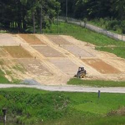U.S. Department of Agriculture (USDA) scientists in West Virginia are finding ways to improve soil on degraded land so it can be used for sports fields and other uses. Researchers with USDA’s Agricultural Research Service (ARS) at the agency’s Appalachian Farming Systems Research Center (AFSRC) in Beaver, W.Va., are developing constructed or replacement subsoils and topsoils to build better and less-costly sports fields, raingardens and lawns on former landfills, mine lands and other degraded land. ARS is USDA’s principal intramural scientific research agency.
The constructed soil research project is in its fourth year. ARS is conducting the research in cooperation with the National Turfgrass Research Initiative, Inc., a joint turfgrass industry-ARS program created in 2007. The initiative draws on the expertise of scientists with ARS and at universities, according to lead scientist Rich Zobel at AFSRC.
The turfgrass industry has set a high priority on improving degraded soils by constructing soils that include readily available rural, urban and industrial byproducts that can be mixed with local soils. These byproduct mixes are being tailored to not only reduce rain runoff and erosion, but also to remove or neutralize pollutants before they reach storm drains.
With lower costs through using inexpensive local byproducts, schools and local parks have a better chance of being able to afford soil replacement for better turfgrass survival. Eliminating compacted soil is the first step toward growing good, robust grass.
The most promising mixture so far includes quarry byproducts and composted chicken litter. It has met predetermined requirements such as the ability to transmit stormwater.
Zobel and his colleagues develop recipes for constructing designer soils from various materials in Ohio, Kentucky, Tennessee, West Virginia, Virginia and southern Pennsylvania.



